Welcome to FISH FOOD TIMES
Oct. 2018 issue No.178

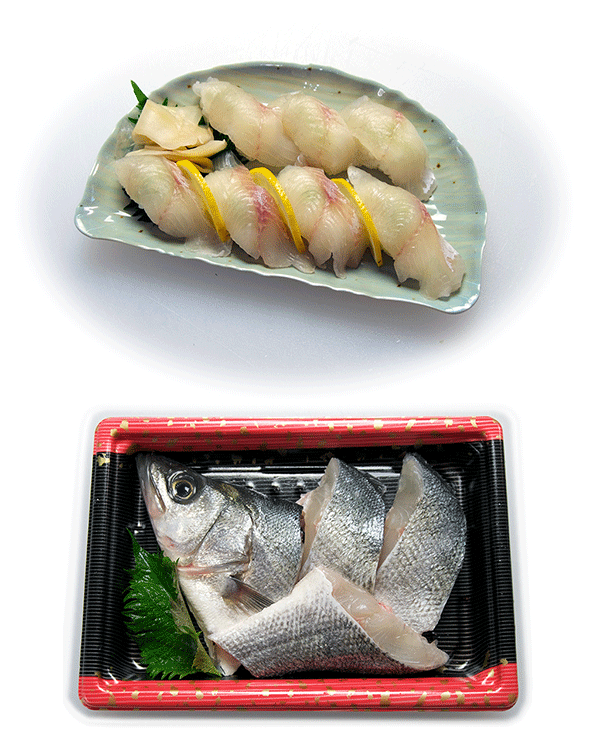
Blackfin seabass sushi & slice
Not Japanese seabass, blackfin seabass
In the previous issue of FISH FOOD TIMIS, I think that I have to pick up Japanese seabass so far, but I have missed opportunities to treat them as a theme.
The reason for this was that I felt somewhat hesitant to use Japanese seabass as a raw material for sashimi and sushi. One of the reasons is that the color of the subcutaneous pattern remaining after removing the skin is not red and is close to brown and its color is not so good that it does not look good even if commercialization of raw food is done. Secondly, it is sometimes hit by a muddy body about nature, not aquaculture, the third one is that it is easy to crack and disintegrate when dismantling, as a product of a fish store has some difficult side to handle . In addition to well-known techniques such as "Arai", there are circumstances in which the idea of what kind of point of view should be dealt with does not come up and there has been a long way to go.
However, it is not the case with a blackfin seabass, but its name and figure are similar, but it is not a particularly difficult fish to handle.
The following image is blackfin seabass.

The Japanese name Hirasuzuki is called Yahiro in Fukuoka Prefecture and Okisuzuki in Kochi Prefecture and belongs to the Perciformes order, Percoidei suborder, Lateolabracidae family, Lateolabrax genus, and in autumn and winter in the season the Japanese seabass is indeed cold. Unlike Japanese seabass, the color is brilliant, red and transparent with white texture, so it is generally traded at a considerably higher price than Japanese seabass because it looks better when it is commercialized than Japanese seabass It is a high grade fish.
Compared with Japanese seabass in the image below, the body height is high, the body shape is flat, the tail fin's root is thick, the tail fin is shallow, the eyes are slightly larger than the Japanese seabass, and they are similar but different I think that you can understand.

Blackfin seabass is distributed in the Pacific Ocean side from the Boso Peninsula to Yakushima, from the Noto Peninsula to the Japan Sea side, along the south coast of the Korean Peninsula. The adult fish mainly inhabits the rocky reef facing the open sea and does not invade much into the large inner bay, but in winter it appears in the estuary such as Tosa Bay facing the Pacific Ocean for juvenile fish and fry fish.
Blackfin seabass is said to be a mysterious fish, its egg-laying ecology has not been confirmed yet, but its ecology has not been elucidated much, such as the sea area caught by the season changes, but for fishers it is very popular It seems like a high fish, blackfin seabass fishing competitions are being held.
One of its attractions is that the main habitat of blackfin seabass will be a rough ocean facing the open sea from autumn to spring, and it will not catch a calm day and catch when it becomes rough weather, so fishing It seems that there are also difficulty levels of upgrading. After all blackfin seabass is called by "ali" of "rough shoreline king" or "sarashi incarnation", the wave front crushed by the winter seasonal wind, the wave front broke and scattered, the white bubble called "sarashi" spreads on the sea surface, That is that the angler is a longing fish crying for the encounter.
Commercialization of blackfin seabass
I tried to commercialize the blackfin seabass having such characteristics to fillets and sushi as follows.
| Blackfin seabass disassembling and commercialization process into fillets | ||
|---|---|---|
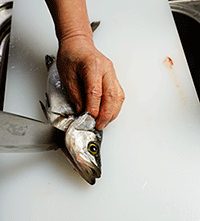 |
 |
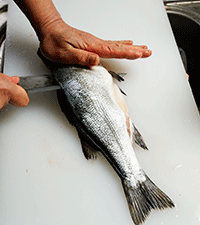 |
| 1, Cut the gills film and cut off the tip of a collar of fish. | 6, Pull out chiai meat of fish with a tool to remove chiai meat of fish. | 11, Cut forward from the incision near tail fin, with its cutting edge toward the head. |
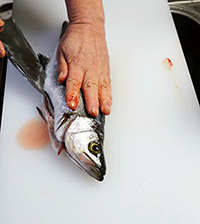 |
 |
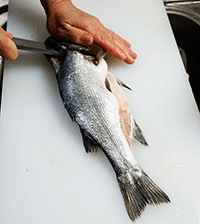 |
| 2, Split the abdomen into two. | 7, Wash the entire fish body, wipe off moisture, then cut off from buttocks bire of lower body. | 12, Cut the cutting edge as it is to the head, divide the head in half. |
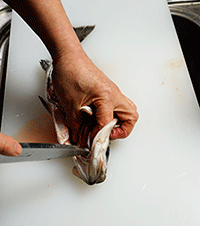 |
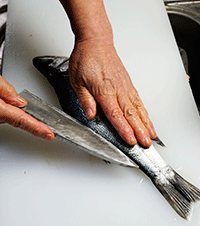 |
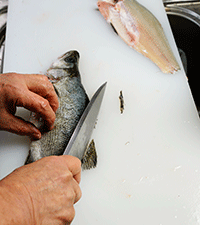 |
| 3, Detach one end of the gills root. | 8, Put a notch at the blade edge of the knife at the dorsal side of the lower body. | 13, Cut off the half of the dorsal fin with the head split in half and the backbone. |
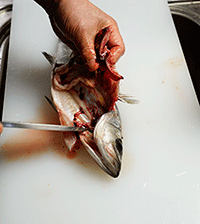 |
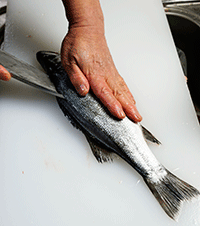 |
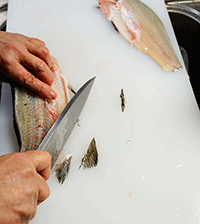 |
| 4, Separating the 2nd place of the gills root, separate the internal organs as it is. | 9, From the side of the tail fin toward the head, go forward on the backbone. | 14, Turn the backbone up and separate buttocks bire, pelvic fin, pectoral fin using the knife blade of the kitchen knife. |
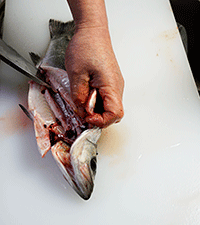 |
 |
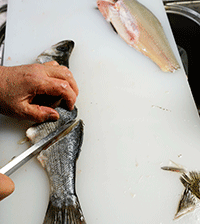 |
| 5, Notch to the chiai meat of fish along the backbone with the knife's tip. | 10, Turn the cutting edge a little toward the tail fin. | 15, cut the heads a little to avoid merely leftover fish scraps, and cut off the rest as much as possible to the same size. |
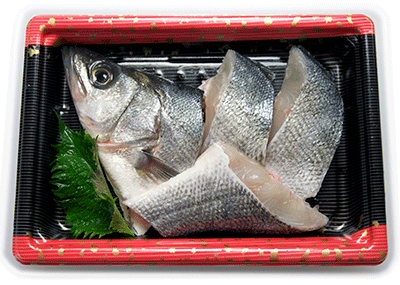 |
||
| Blackfin seabass fillet | ||
I made this fillet into boiled fish dishes.
| Boiled fish process of blackfin seabass |
|---|
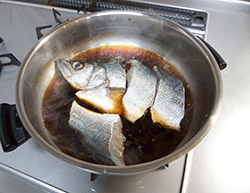 |
| 1, Put a slice in a boiled broth. |
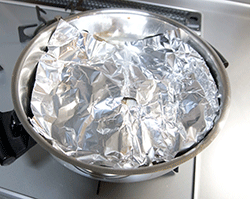 |
| 2, Drop lid of aluminum foil. |
 |
| 3, finish it with broth several times with ladle. |
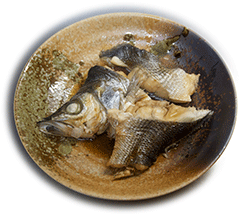 |
| Boiled fish of blackfin seabass |
Next, make the sushi material of sushi with half the body without the backbone.
| Blackfin seabass's nigiri sushi commercialization process | |
|---|---|
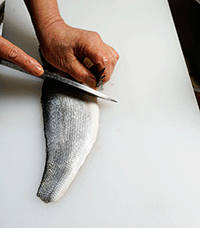 |
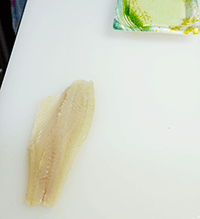 |
| 1, Cut off the head of the lower body at the angle of tasukiotoshi. | 5. Using the bonning tool, remove the small bone in the half body from which the skin is removed and place it with the leather side facing down. |
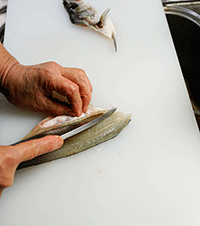 |
 |
| 2, Notch the cutting edge under the abdomen. | 6, Pull the yanagiba kitchen knife along the angle of the cut of the belly side of the lower body. |
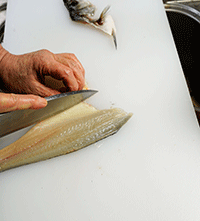 |
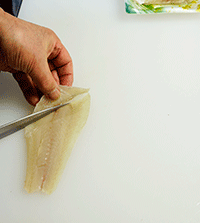 |
| 3, Pull the kitchen knife, cut it thinly, cut off the belly bone. | 7, leave a piece of leather, set up the cutting edge of yanagiba kitchen knife, cut off with kirikado. |
 |
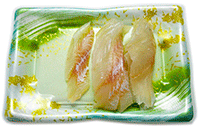 |
| 4, Pull the leather strongly with your left hand, put yanagiba kitchin knife between the body and the skin, and go to the side of the head. | 8, Trim the length of about 5 width of fingers, and the width of 2 fingers as a guide to the same length. |
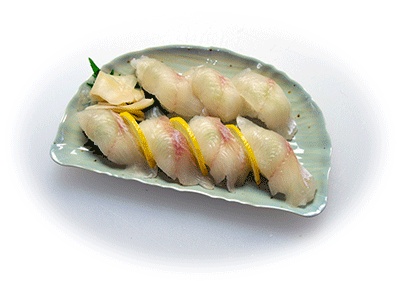 |
|
| blackfin seabass nigiri sushi | |
Blackfin seabass's nerve extraction and blood extraction videos
By the way, the method of "fish nerve extraction and blood extraction" called "Tsumoto-type ultimate blood extraction" has become a hot topic on youtube videos.
By chance, that video introduces a method of "Tsumoto expression ultimate blood extraction" using blackfin seabass which is the protagonist of this month issue, this time we decided to link to the same blackfin seabass. This video is not related to blackfin seabass itself, just finding fish used as a model of blood extraction by chance blackfin seabass, actually there are various animations using other fish such as flounder.
Anyway this video is interesting and funny content, so tentatively readers would like to see the following blackfin seabass edition.
Tsumoto Mitsuteru, Sales Manager of Hasegawa Fisheries in Miyazaki Prefecture, invented and started blood extraction with existing marketing tools, now devising tools specifically for blood extraction It seems that it is also being sold.
However, perhaps in the workshop of a fish shop recently, it seems that there are few places to do nerve extraction and blood extraction work like movies. Because in the case of a fish shop the immediatlly killing work of live fish should have ended at the stage of the wholesaler before the fish have already been transported to the store.
Looking back on the past, there were times when it was booming to have live fish tanks at the super fish store over 20 years ago. It costs millions of yen just by installing the aquarium, and there is also a large maintenance cost side after that. The fact that the acrylic tank is in the fish shop was the thing that appealed as if it is a proof that it is a product line of fresh fish was present in stores all over the country.
And the author became a fresh fish consultant about thirty years ago, and the work that was done at the beginning was "Removal of live fish tank" in the super
People who think that fish in the aquarium that is still alive and swimming is lively and fresh and delicious is obliged to be a person who does not know much about the fish to eat. Because fish are not given enough baits, the longer it is in the aquarium, the longer it consume fat accumulated in the fish body, becoming a thin lean fish with less fat. Since I knew that the fish in the aquarium existed as a demonstration type basically, the author made a proposal to remove the meaningless live fish tank from the supermarket in each place due to poor cost performance for fish shops in stores.
Even now there are shops that have live fish tanks in Japanese restaurants and other dishes, but they should be used only for temporary storage of live fish and shellfish. If you keep your live fish at rest for as long as a day in aquarium, this is the state "ikekosu". This is to put the fish in a rest state, lactic acid which was ramped when it is landing, dissolved in lactic acid is eliminated, ATP is recovered, there is no big influence on the taste of the fish.
Although it seems that there are almost no stores like signboards of live fish tanks in modern supermarkets, there are shops in every part of the country that have a well-reputed fish shop, not only fish that rigor mortised , immediatlly killing fish and natural fish before rigor mortis are likely to arrive in many cases.
Sometimes, it seems that such living natural fish may be much cheaper than the normal price, but even if they are cheap, they should purchase only the usual amount and should purchase such an amount of fish that can not be sold out in a day. And by doing the "Tsumoto-type ultimate blood extraction" method in the above movie, I think that it may be good to treat those fish carefully and sell well over several days.
Because it seems that the method of blood extraction which makes good use of water pressure of this tap water seems to be applicable even if it is not after immediatlly killing unless blood is solidified before rigor mortis. Depending on the freshness of the fish, it is considered that the same storage method which is carried out in the movie can be done in the workplace of the super fish sector.
For example, during the year-end / New Year holidays where the fish market is absent from work, this method is considered to be very effective, and it may be avoided from the circumstances where you only have to rely on the limited fillet vacuum fish for that period.
The "Tsumoto formula ultimate blood extraction" method introduced here is not a collection of advanced knowledge in particular, it is a "crystal of wisdom" which is drawing out excellent results by applying common tools of a few I would like to say that this is a "fish industry invention" worthy of praise.
Well, it was greatly misplaced from the theme of blackfin seabass. Actually, anglers may have topics so as not to be able to to all about the blackfin seabass, but as a position to sell fish there are not so many topics about blackfin seabass. Speaking of the real intention, I used this to deviate to the sideways.
Even though I know the word aging of beef, I remember the era a long ago when I thought that the word "aging" is not very relevant to fish. When it is possible to ripen fish such as 5 days or 1 week by such a blood extraction method, it seems that a new era is also coming to fish sales methods.
For example, fish with clear traceability such as aquaculture raw tuna, etc., the storage method in the ripening period already assuming traceability has become commonplace. The movement premised on this ripening seems to further expand momentum and expand as "Tsumoto-type ultimate blood extraction" method widens more and more.
Because the state of fish landing in Japan's neighboring seas has been changing since the past, it should not be surprising if changes will also appear in the sales method at the fish shop. I would like to make sure not to miss that change.
An opinion and the communication are to iinfo@fish food times
Date of updating 1 Oct. 2018
